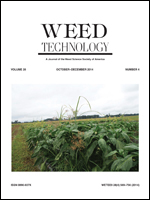Sugarcane growers have observed reduced residual activity of atrazine on organic soils in the Everglades Agricultural Area (EAA) of south Florida. Field studies were conducted between 2011 and 2012 to determine the rate of dissipation of atrazine at 2.24, 4.48, and 8.96 kg ha−1 and metribuzin at 0.56, 1.12, and 2.24 kg ha−1 in the top 10 cm of soil in sugarcane fields in the EAA. The bioavailable fraction of atrazine dissipated more rapidly than the total amount of atrazine in the soil. Half-lives of the total and bioavailable fraction of atrazine ranged between 3.9 to 12.1 d and 1.0 to 7.5 d, respectively. Metribuzin dissipated much more slowly than atrazine on organic soils. Similarly, dissipation of the bioavailable fraction of metribuzin was more rapid than was the dissipation of the total amount of metribuzin in the soil. Half-lives of the total and bioavailable fraction of metribuzin ranged between 16.2 and 24.8 d and 6.0 and 14.3 d, respectively. These results indicate that enhanced atrazine degradation occurs on organic soils under field conditions in the EAA, resulting in shorter residual atrazine activity. This implies that metribuzin is a better option for weed control in sugarcane grown on organic soils of the EAA exhibiting enhanced atrazine degradation.
Nomenclature: Atrazine; metribuzin; sugarcane, Saccharum spp. hybrids.
Productores de caña de azúcar han observado una actividad residual reducida de atrazine en suelos orgánicos en el Área Agrícola Everglades (EAA) en el sur de Florida. Se realizaron estudios de campo entre 2011 y 2012 para determinar la tasa de disipación de atrazine a 2.24, 4.48, y 8.96 kg ha−1 y metribuzin a 0.56, 1.12, y 2.24 kg ha−1 en los 10 cm superiores de suelo en campos de caña de azúcar en el EAA. La fracción biodisponible de atrazine se disipó más rápidamente que el total de atrazine en el suelo. La vida media de las fracciones total y biodisponible de atrazine variaron entre 3.9 y 12.1 d y 1.0 y 7.5 d, respectivamente. Metribuzin se disipó mucho más lentamente que atrazine en suelos orgánicos. Similarmente, la disipación de la fracción biodisponible de metribuzin fue más rápida que lo que fue la disipación de la cantidad total de metribuzin en el suelo. La vida media de las fracciones total y biodisponible de metribuzin varió entre 16.2 y 24.8 d y 6.0 y 14.3 d, respectivamente. Estos resultados indican que la degradación acelerada de atrazine ocurre en suelos orgánicos bajo condiciones de campo en el EAA, lo que resulta en una actividad residual de atrazine más corta. Esto implica que metribuzin es una mejor opción para el control de malezas en caña de azúcar sembrada en suelos orgánicos del EAA que exhiben degradación acelerada de atrazine.





